Treating blister burns at home
You can heal 1st and 2nd degree burns on your own. With such damage, the skin turns red and blistered. Treatment of burns with blisters at home is carried out using folk remedies (baths, ointments, infusions) or special medicines (creams, antiseptic sprays).
1st and 2nd degree burns can be cured at home
First aid for burns with blisters
The appearance of blisters on the affected area indicates deep skin damage or a 2nd degree burn.
Factors to pay attention to before giving first aid:
- Damage area. Burns of the 1st degree, occupying a large area (more than 10%) of the skin, require medical intervention, regardless of location. As a rule, when receiving extensive injuries, a person is in a state of pain shock and cannot soberly assess his condition.
- The age of the victim. The child has a lower pain threshold, so he will feel the pain of a burn more acutely. Also an important factor is that children under 6-8 years old have thinner skin, which is easier to injure. Accordingly, even with a minor burn, there is a high risk of damage to muscles and ligaments. For this reason, young children are best seen by a doctor immediately after an injury.
- Localization. The most dangerous and intractable are burns of the face and mucous membranes.
All burns are divided into 4 types:
- thermal (appear when the skin comes in contact with hot objects, hot water or fire);
- electrical (occur when struck by a lightning discharge or current);
- chemical (occur as a result of exposure to the skin of industrial or household chemicals, heavy metals);
- radiation (appear due to radioactive sources, sunburns also belong to this type).
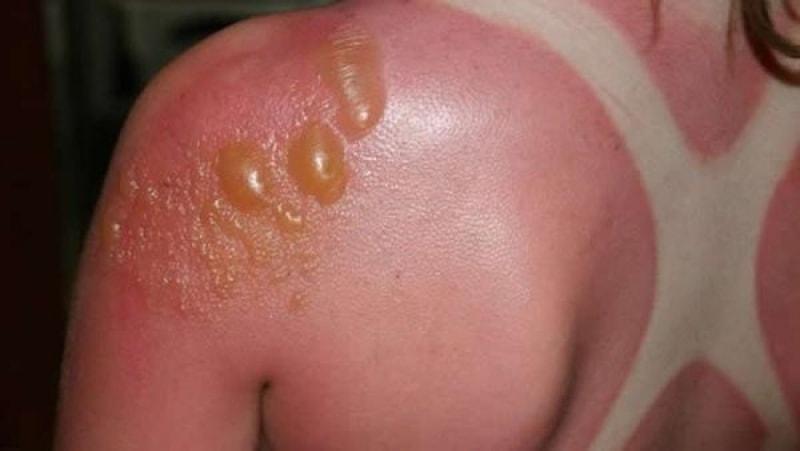
You can get a severe burn if you stay in direct sunlight for a long time.
Post-burn complications - nausea, fever, fever, chills, palpitations.
Emergency first aid for burns - in stages:
- Try to quickly determine the extent of the burn. This can be done by looking at the area and depth of the damage. Serious injuries are also indicated by symptoms such as: the appearance of blisters with blood streaks, charring (blackening) of the skin, the formation of a yellow or brown burn crust, and the complete absence of pain in the victim. If you suspect a deep injury, you need to call an ambulance. 3rd and 4th degree burns do not need to be treated with cold water.
- Grade 1 and 2 injuries require cooling. A household burn is most easily treated with cold water. The liquid should not be icy, the optimum temperature is 12-19 ° C. The affected area should be kept in cold water for 10 minutes. The procedure will help relieve pain by reducing the sensitivity of nerve endings.
- Bandage application. If there is clothing on the affected area of the skin, then it must be cut off very carefully. Damaged skin should not be touched or attempted to be cleaned of any pieces of cloth, resin, and so on. The burned area should also not be treated with various herbal decoctions or solutions like greens. Any clean, dry cloth will work to make the bandage. A burn on a finger requires the use of additional material (for example, a bandage). It must be moistened with cool water and placed between the fingers to prevent further sticking.
- The use of painkillers. The victim may also need antipyretic drugs. You need to focus on the symptoms that disturb the person after the injury. Often, basic medications are suitable for their elimination: Paracetamol, Aspirin, Ibuprofen.
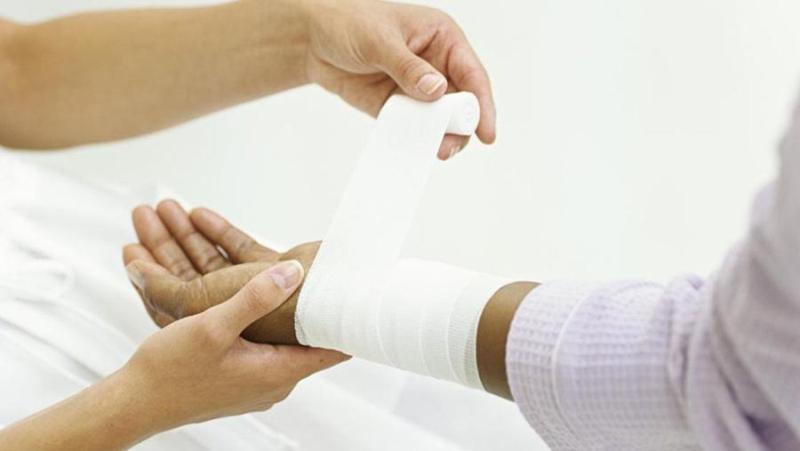
Apply a clean bandage to the injured area
This first aid scheme is the same for almost all household injuries. With its help, you can treat a thermal burn with boiling water, hot oil or steam. According to this principle, sunburn and damage left after cans on the back are also neutralized.
If you get injured due to household chemicals, you need to wash the affected area more thoroughly and longer. The treatment time with cool water should be increased to 20-30 minutes. The procedure can be completed as soon as a strong burning sensation disappears.
In some cases, it will be appropriate to use the ointment immediately. For example, if small blisters appear during overexposure of medical jars, they can be eliminated with the help of agents such as Bepanthen plus or Panthenol.
To avoid repeated thermal damage, do not leave medical cups for more than 10 minutes.
What to do with a burn with blisters at home
The affected area should be treated with medication immediately after removing the bandage. Ideally, it should be removed by a specialist, since only he can accurately assess the degree of damage and prescribe the most appropriate drugs. Before removing the bandage, you should also take painkillers. For greater efficiency, the injured area should be treated with an anesthetic (for example, Lidocaine solution).
What not to do:
- apply vinegar or soda to the affected area;
- treat the burned area with iodine;
- sharply peel off the bandage from the burn;
- lubricate the injured area with fermented milk products.
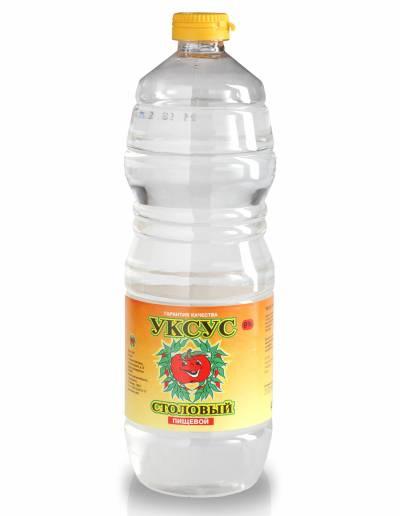
Do not use vinegar to treat burns
In no case should you buy homeopathic remedies for the treatment of burns. At their rather high cost, they do not help at all.
Preparations for external use
How to remove blisters? To do this, you need to use external medicines for 2-5 days. They act directly on the affected area, so they help to quickly get rid of blisters and redness.
After the use of medications, you need to intensively care for injured skin. It will peel off for a while, so it's best to use the most affordable moisturizer and softener - Vaseline. Creams with fragrances are highly undesirable.
The best pharmacy products for burns:
- A tool that helps speed up the healing of the burned area of the skin. It is used to treat burns of all types. The drug must be applied in a thin layer to the injured area. The medication should be smeared 3-4 times a day, lightly rubbing it into the skin. The cream should be used until the burned area is completely healed.
- Furacilin. The medicine is sold in the form of tablets for the preparation of an antiseptic solution. The drug is used for burns of 1, 2 and 3 degrees. It should be applied at the moment when the blister has just formed. It is also recommended to use an antiseptic before applying any healing cream or ointment. If the burn bubble bursts, then Furacilin will be needed to treat the affected area. It should be used 2-3 times a day to avoid contamination of the wound. The tool helps with any burns.
- Miramistin. Antiseptic, sold in the form of a solution and spray. Easy to use, suitable for cupping deep and superficial burns. The drug also has a bactericidal effect. It must be applied during the initial treatment of burned skin, as well as before using various ointments. With sunburn and chemical burns, you can apply a bandage soaked in a 0.01% Miramistin solution and change it once a day.
- Bepanten. Ointment that accelerates tissue regeneration. It can treat superficial thermal burns. Also, the product is suitable for the subsequent care of damaged skin, as it has a moisturizing effect. Bepanten should be used 1-2 times a day. The medication should be applied in a thin layer and rubbed in lightly.
- Pantoderm. Moisturizing and regenerating ointment. With its help, you can treat shallow burns (in particular, sunburns). In order to get the fastest result, the product should be applied 2-3 times a day.
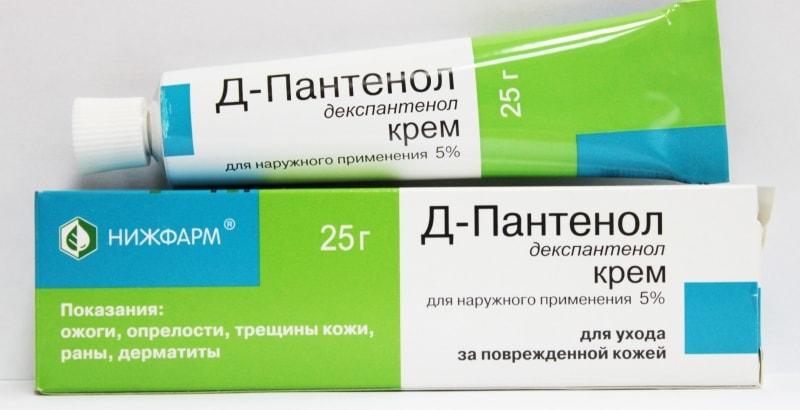
D-Panthenol will help heal the burn faster
Small superficial burns heal perfectly without the use of regenerating agents. Such drugs are needed to speed up this process, but their use is not mandatory. It is much more important to use antiseptic sprays and solutions to protect the affected area from various contaminants.
For quick treatment of burns, you can use special patches (Cosmos, Branolind N, Parapran). Such medicines help when the blister is already inflated and you want to remove it as soon as possible. Bactericidal patches are impregnated with a special lotion that accelerates tissue healing.
Treatment with folk remedies
Folk remedies are not as effective as pharmacy ones, but they can be used for small superficial burns. Moisturizing ointments for the care of damaged skin can be made independently using petroleum jelly or propolis as a base.
carrot bandage
You need to take 1 small fresh carrot and grate it. The crushed plant should be placed on a clean cloth or gauze. The finished bandage should be applied to the burned area and held for 40-45 minutes.
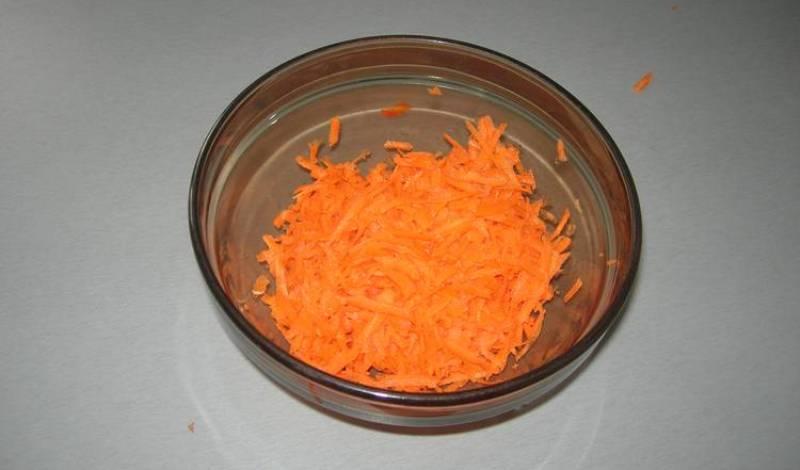
Before applying the compress, carrots must be chopped
Cabbage leaves can also be used as a natural dressing. They help relieve swelling and eliminate redness.Aloe for thermal burns
You will need a fresh aloe leaf. It must be thoroughly rinsed so that no dust remains on the plant. After that, it is necessary to cut off the entire top skin from aloe and attach it to the damaged area with a bandage or gauze.
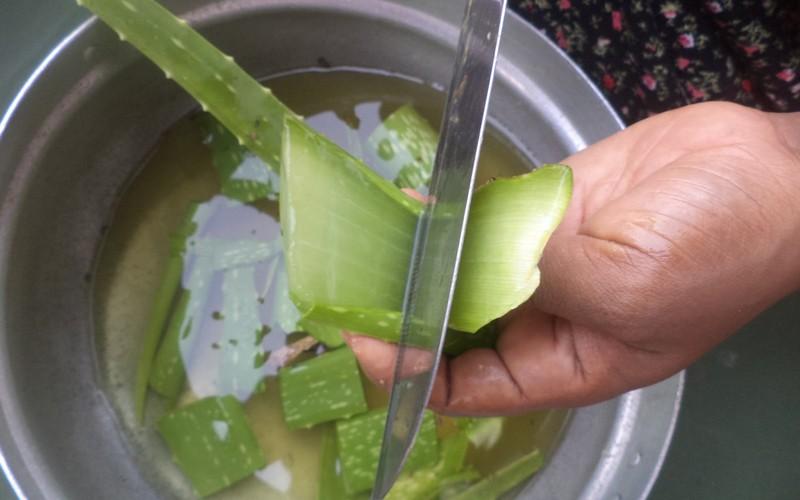
The top of the aloe skin needs to be cut off.
Aloe has a calming and antiseptic effect. The plant helps when the blister is already swollen. A kind of aloe bandage should be applied to the burn 2 times a day.
You will need: half a glass of water, 3 tablespoons of calendula, petroleum jelly. First you need to prepare a decoction, for this you need to pour boiling water over the calendula and put on a small fire. After 5 minutes, turn off the burner and let the broth brew for an hour. Subsequently, the mixture must be filtered and vaseline added to it in proportions of 1: 2.
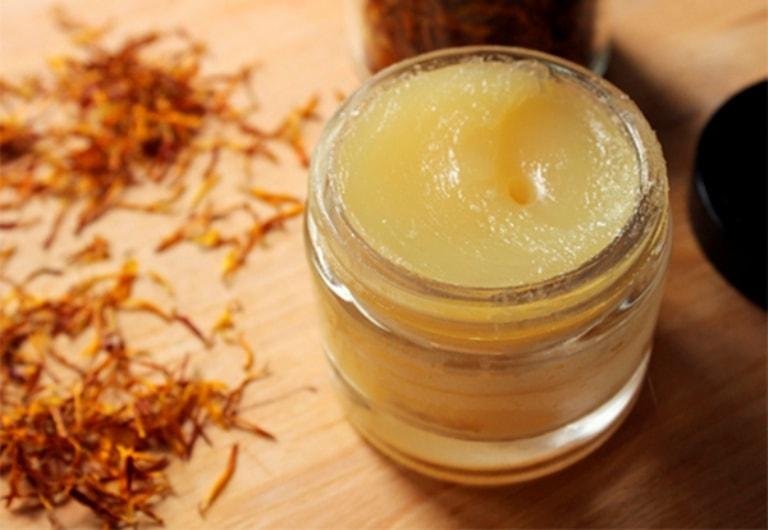
Calendula ointment is good for getting rid of blisters
The product should be stored in a cool place, preferably in the refrigerator. The ointment is good for blisters. It should be applied 2-3 times a day to the burned area.
Propolis and beeswax
Propolis has a healing and antiseptic effect. The tool is contraindicated for use by people prone to allergic reactions.
You will need:
- olive oil - 100 ml;
- propolis - 30 gr;
- beeswax - 50 gr.
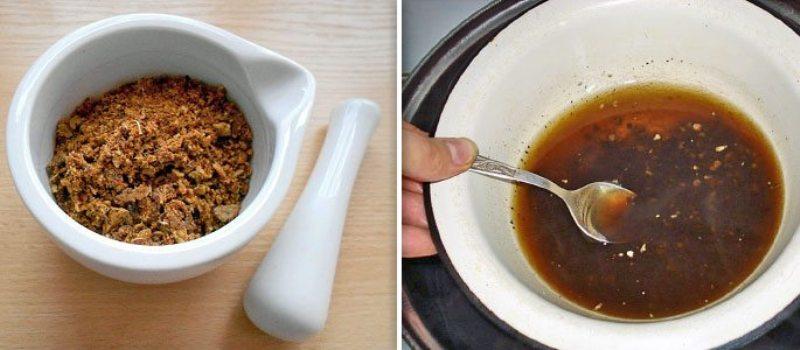
Propolis and wax need to be melted in a steam bath
It is necessary to place all the components in a saucepan and melt with a water bath. The mixture must be brought to a homogeneous consistency. Keep the ointment in the refrigerator, before use it must be heated. If necessary, apply the agent to the affected area in a thick layer 2 times a day.
It is necessary to take 1.5 tablespoons of linden and pour 300 ml of boiled hot water. The mixture must be allowed to infuse for 3 hours. After this, the infusion must be filtered. Soak gauze with this mixture, and then apply it as a compress to the burnt area. After half an hour, the bandage can be removed. Linden infusion relieves redness and protects the injured area of the skin from infection.
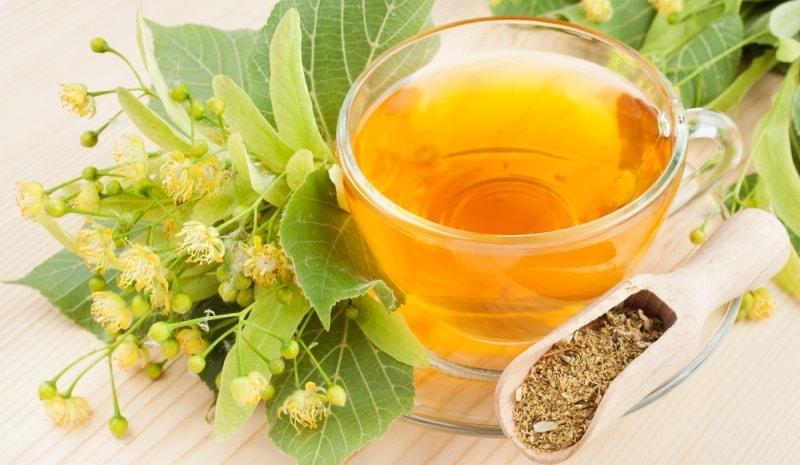
Linden infusion relieves redness from the burned area
herbal bath
To make a bath, it is best to take a ready-made herbal mixture (200 gr). You can make it yourself, but for this you need to first dry and grind chamomile, valerian root, St. John's wort, celandine, string and sage. All these herbs together give a healing and soothing effect, due to which the burn stops hurting.
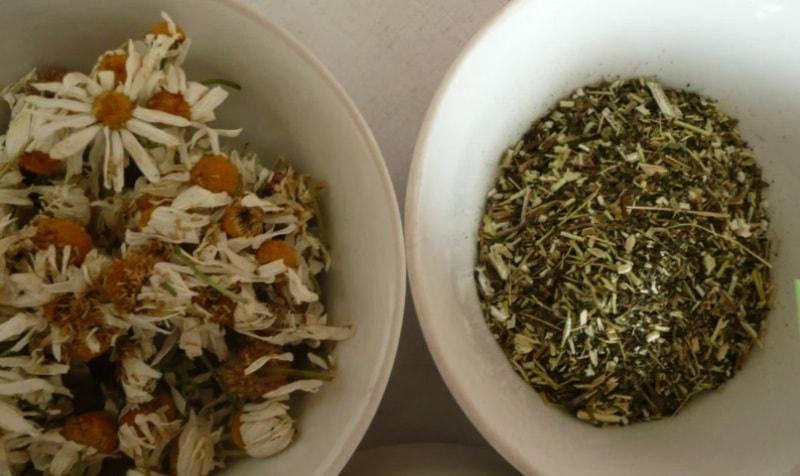
To prepare the bath, you need to use dried chopped herbs.
200 g of herbal mixture should be placed in a bowl of warm water. The container should contain 3.5-5 liters of liquid. The mixture must be allowed to cool and infuse for 2 hours. As a result, the bath should be cool. Soak the affected area in it for 15-20 minutes.
Plantain for blisters
To prepare a medicinal infusion, you need to take 2-3 tablespoons of crushed plantain leaves (dried or fresh). They must be poured with a glass of hot boiled water and left for 10-12 minutes. After that, the infusion can be used to wet the gauze and then make a bandage. The tool should be used 1 time per day until the complete disappearance of blisters.
All folk methods of treatment are strongly recommended to be combined with medicines.
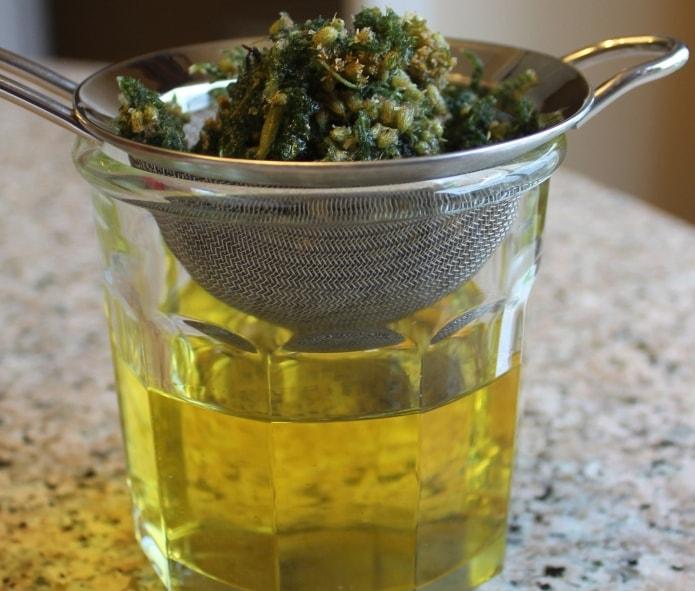
A decoction of plantain will help heal the burn
Question answer
Is it possible to open a bubble from a burn?
To pierce or not is the most common question among people who have received a small burn with blisters. Therefore, it is worth remembering the basic rule: you cannot open a blister on your own (even with a sterile medical needle).
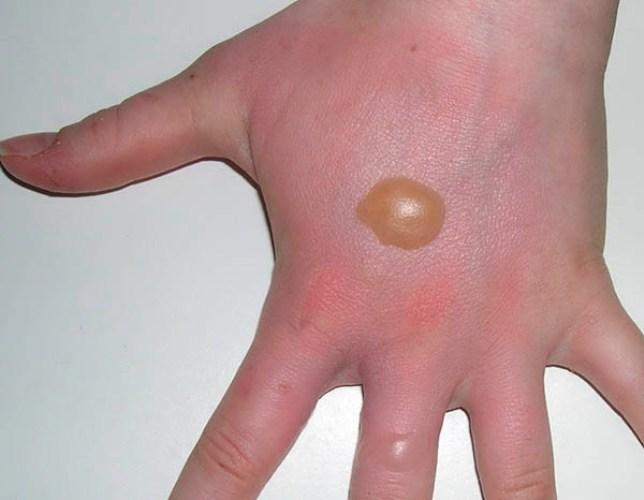
You can not open a bubble from a burn yourself
What happens if a burn bubble bursts?
The bubble is a kind of protection for injured skin, susceptible to pathogenic microflora. If it bursts, then you can get a number of complications, among which the most common is suppuration of the wound. In addition, after opening the bladder, a scar may form on the skin, reminiscent of a burn.

If the bubble bursts, then the wound may fester
When do blisters go away after a burn?
With the use of drugs, the blisters disappear within a few days. Without medical intervention, the blisters disappear on average in a week. With small superficial injuries, the blisters go away quickly and without complications.
If the affected person has a consistently elevated temperature (up to 38-39 degrees), which does not subside within 12 hours, then you should consult a doctor. The same must be done with increased pain syndromes on the second or third day after the burn.
